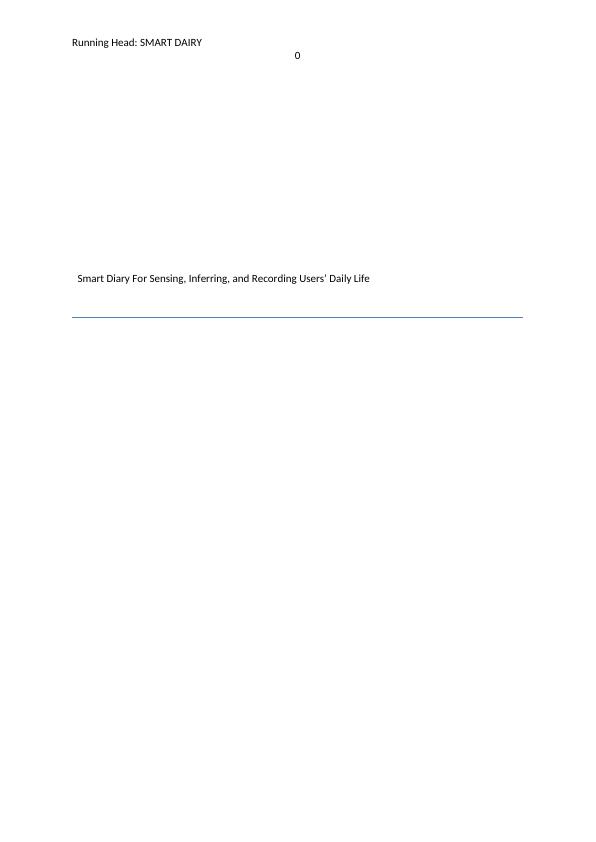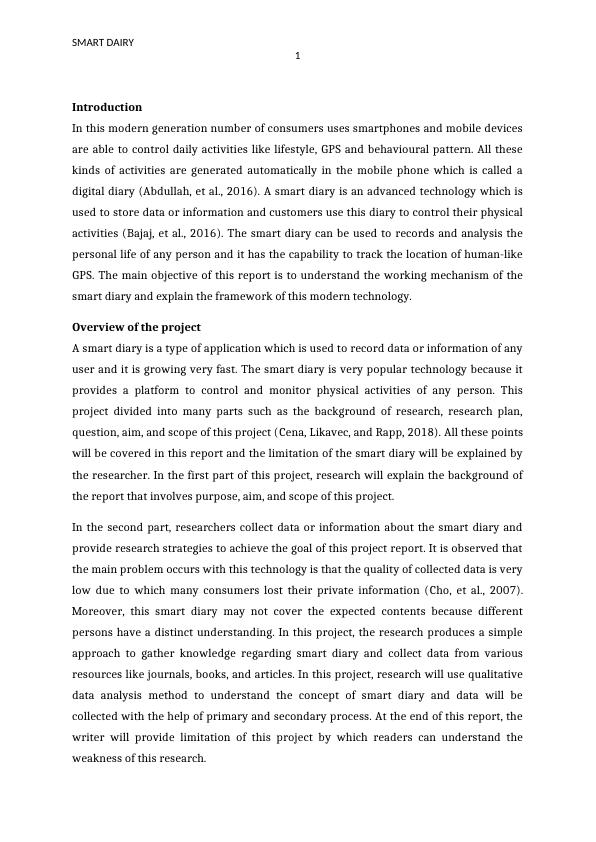Smart Diary For Sensing, Inferring, and Recording Users’ Daily Life
Added on 2023-06-03
9 Pages3229 Words179 Views
Running Head: SMART DAIRY
0
Smart Diary For Sensing, Inferring, and Recording Users’ Daily Life
0
Smart Diary For Sensing, Inferring, and Recording Users’ Daily Life

SMART DAIRY
1
Introduction
In this modern generation number of consumers uses smartphones and mobile devices
are able to control daily activities like lifestyle, GPS and behavioural pattern. All these
kinds of activities are generated automatically in the mobile phone which is called a
digital diary (Abdullah, et al., 2016). A smart diary is an advanced technology which is
used to store data or information and customers use this diary to control their physical
activities (Bajaj, et al., 2016). The smart diary can be used to records and analysis the
personal life of any person and it has the capability to track the location of human-like
GPS. The main objective of this report is to understand the working mechanism of the
smart diary and explain the framework of this modern technology.
Overview of the project
A smart diary is a type of application which is used to record data or information of any
user and it is growing very fast. The smart diary is very popular technology because it
provides a platform to control and monitor physical activities of any person. This
project divided into many parts such as the background of research, research plan,
question, aim, and scope of this project (Cena, Likavec, and Rapp, 2018). All these points
will be covered in this report and the limitation of the smart diary will be explained by
the researcher. In the first part of this project, research will explain the background of
the report that involves purpose, aim, and scope of this project.
In the second part, researchers collect data or information about the smart diary and
provide research strategies to achieve the goal of this project report. It is observed that
the main problem occurs with this technology is that the quality of collected data is very
low due to which many consumers lost their private information (Cho, et al., 2007).
Moreover, this smart diary may not cover the expected contents because different
persons have a distinct understanding. In this project, the research produces a simple
approach to gather knowledge regarding smart diary and collect data from various
resources like journals, books, and articles. In this project, research will use qualitative
data analysis method to understand the concept of smart diary and data will be
collected with the help of primary and secondary process. At the end of this report, the
writer will provide limitation of this project by which readers can understand the
weakness of this research.
1
Introduction
In this modern generation number of consumers uses smartphones and mobile devices
are able to control daily activities like lifestyle, GPS and behavioural pattern. All these
kinds of activities are generated automatically in the mobile phone which is called a
digital diary (Abdullah, et al., 2016). A smart diary is an advanced technology which is
used to store data or information and customers use this diary to control their physical
activities (Bajaj, et al., 2016). The smart diary can be used to records and analysis the
personal life of any person and it has the capability to track the location of human-like
GPS. The main objective of this report is to understand the working mechanism of the
smart diary and explain the framework of this modern technology.
Overview of the project
A smart diary is a type of application which is used to record data or information of any
user and it is growing very fast. The smart diary is very popular technology because it
provides a platform to control and monitor physical activities of any person. This
project divided into many parts such as the background of research, research plan,
question, aim, and scope of this project (Cena, Likavec, and Rapp, 2018). All these points
will be covered in this report and the limitation of the smart diary will be explained by
the researcher. In the first part of this project, research will explain the background of
the report that involves purpose, aim, and scope of this project.
In the second part, researchers collect data or information about the smart diary and
provide research strategies to achieve the goal of this project report. It is observed that
the main problem occurs with this technology is that the quality of collected data is very
low due to which many consumers lost their private information (Cho, et al., 2007).
Moreover, this smart diary may not cover the expected contents because different
persons have a distinct understanding. In this project, the research produces a simple
approach to gather knowledge regarding smart diary and collect data from various
resources like journals, books, and articles. In this project, research will use qualitative
data analysis method to understand the concept of smart diary and data will be
collected with the help of primary and secondary process. At the end of this report, the
writer will provide limitation of this project by which readers can understand the
weakness of this research.

SMART DAIRY
2
Background
The smart diary is a kind of software which is used by many peoples to analysis their
daily life activities. It may be a perianal organizer for individuals that can be used for
health tracker, secret diary, tasks manager, and monitor the daily life of consumers. A
personal diary is defined as a process to records individuals’ experience, their feelings,
and ideas. Anne Frank is the best example of the smart diary that can read books and
control user’s daily activities (Diao, et al., 2016). It involves different types of sensors
and devices which are connected to smartphones and GPS is used to track the location
of any person. This type of technology makes the main four contributions, for example,
it can represent user daily life with the help of the narrative process, a practical process
is used to make inferences and produce smart diaries, produce two way process to solve
issues of data analysis process, and give an accurate and effective algorithm programme
by which consumers can secure their data (Harari, et al., 2017). To develop this type of
innovation there are few challenges faced by research such as first data is collected
through the heterogeneous raw process to read data that take more time, personalize of
information is very complex process, and this diary is established in a particular
language therefore, it needs a new model to arrange raw data. There are main four
layers of smart diaries such as raw data collection, event personalization, generation of
dairy and context analysis. The raw data collection process is used to comprehensive
consumer’s profiles with the help of motion activities, location information, and call
history. Context analysis layer is used to extract data or information from raw data and
it has the ability to control the motion of user activities (Jalal, Kamal, and Kim, 2014).
Event personalization layer is used for filtering and ranking process by which users can
filter their activities. The filtering step runs very fast and algorithm of memory saving is
used to select the events of all individuals. At the end of this process, filtered events are
used to produce the layer of the smart diary (Jeong, et al., 2015). Diary generation layer
is used for mapping process and it is also called as narrative structure. In this layer, the
consumer gives the command to dairy and stores their daily life data with the help of
the personalization process and multiple structure models are used because one event
meaning can be expressed into numbers of ways. Some studies utilize smart diaries to
understand the correlation between physical activities like exercise and health issues
like diabetes and the use of this type of technology is increasing very fast. It is observed
2
Background
The smart diary is a kind of software which is used by many peoples to analysis their
daily life activities. It may be a perianal organizer for individuals that can be used for
health tracker, secret diary, tasks manager, and monitor the daily life of consumers. A
personal diary is defined as a process to records individuals’ experience, their feelings,
and ideas. Anne Frank is the best example of the smart diary that can read books and
control user’s daily activities (Diao, et al., 2016). It involves different types of sensors
and devices which are connected to smartphones and GPS is used to track the location
of any person. This type of technology makes the main four contributions, for example,
it can represent user daily life with the help of the narrative process, a practical process
is used to make inferences and produce smart diaries, produce two way process to solve
issues of data analysis process, and give an accurate and effective algorithm programme
by which consumers can secure their data (Harari, et al., 2017). To develop this type of
innovation there are few challenges faced by research such as first data is collected
through the heterogeneous raw process to read data that take more time, personalize of
information is very complex process, and this diary is established in a particular
language therefore, it needs a new model to arrange raw data. There are main four
layers of smart diaries such as raw data collection, event personalization, generation of
dairy and context analysis. The raw data collection process is used to comprehensive
consumer’s profiles with the help of motion activities, location information, and call
history. Context analysis layer is used to extract data or information from raw data and
it has the ability to control the motion of user activities (Jalal, Kamal, and Kim, 2014).
Event personalization layer is used for filtering and ranking process by which users can
filter their activities. The filtering step runs very fast and algorithm of memory saving is
used to select the events of all individuals. At the end of this process, filtered events are
used to produce the layer of the smart diary (Jeong, et al., 2015). Diary generation layer
is used for mapping process and it is also called as narrative structure. In this layer, the
consumer gives the command to dairy and stores their daily life data with the help of
the personalization process and multiple structure models are used because one event
meaning can be expressed into numbers of ways. Some studies utilize smart diaries to
understand the correlation between physical activities like exercise and health issues
like diabetes and the use of this type of technology is increasing very fast. It is observed

End of preview
Want to access all the pages? Upload your documents or become a member.
Related Documents
Living In a Digital World (Doc)lg...
|6
|1269
|271
Drivers’ Distraction While Using Smartphone GPS: A Research Project Proposallg...
|9
|2054
|174
Intelligent Systems for Socially Aware Computing - Study Materiallg...
|11
|2423
|255
Smartphone and Tourism: Implications and Challengeslg...
|4
|891
|91
Facebook as a Tourism and Crisis Communication Tool in Fijilg...
|15
|934
|174
Interacting Socially with the Internet of Things (IoT): Effects of Source Attribution and Specialization in Human–IoT Interactionlg...
|5
|908
|462
